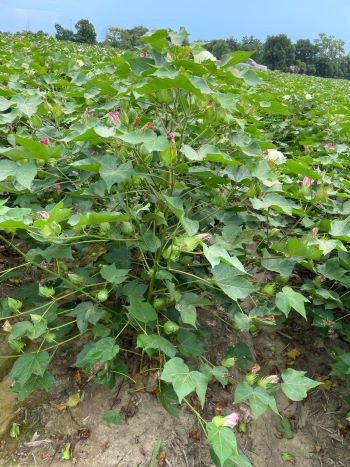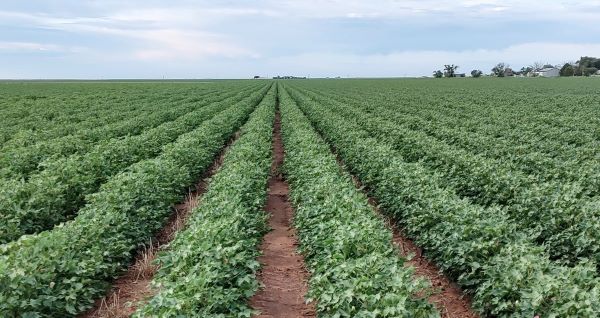Crop Scan Ag Report: Keep the Water Coming
It’s hot, and rain has been scarce in too many regions of the Cotton Belt in mid-August. Irrigated cotton still seems to be okay, but pivots are working overtime to meet water needs. Growers are still managing insects, with disease pressure building in the Southeast.
Here’s what our contributing consultants are saying:
Chad Harrell owns and operates Harrell Agronomic Services in Northeastern North Carolina.
Cotton in our region has advanced rapidly over the past couple of weeks.
We are now in the fifth week of bloom, with some fields beginning to bloom out the top. The rain has been very spotty over the past couple of weeks with many areas in need of moisture. Some of the lighter land has already begun to shed fruit and cut out in the driest areas.
Overall, most of our cotton seems to have a nice boll load and a good yield potential if we can catch a couple more rains this month.
We have seen an increase in insect pressure over the past few weeks, but treatments seem to be working well. We are now about a week into the moth flight and have not seen any issues in the 3-gene cotton so far.
Wes Briggs consults on cotton, corn, peanuts, soybeans, and small grains for growers in Georgia, Alabama, and Florida.
We haven’t had rain here in two weeks, and it’s hot! A bunch of our dryland cotton is blooming out the top, and a bunch of 100-day-old peanuts are starting to wilt. If we don’t get some rain soon, that crop will be done.
It’s a spider mite and stink bug world in the cotton, a lot of loopers in soybeans, and white mold in peanuts. We’re treating more spider mites than we have in a long time. We’re also seeing the end of some whiteflies in a few areas. I sure hope they don’t blow up on us.
We have some older cotton that’s starting to crack bolls this week, and we have cotton that isn’t blooming yet. We need rain badly! We’re not close to being able to cut back on water on cotton or peanuts, and pivots are going as hard as they can right now.
We’re still foliar feeding some cotton. We also found a lot of target spot last week and have sprayed probably half of our cotton acres.
Overall, irrigated cotton is fruiting up well. A lot of cotton is at 4-5 nodes above white flower. For us, that’s still another month of treatments and water. We still have a ways to go. A good rain would help.
Tucker Miller is a Mississippi-based independent private consultant for cotton, soybeans, corn, peanuts, rice, and vegetables.
The cotton crop in our area is coming to an end. We range from node above white flower (NAWF) 1 to NAWF 5 in the later planted cotton.
Dryland cotton held on as long as it could, but rains were too late for a big crop. The dryland crop will be off 200 pounds, but it should still be a decent crop. Irrigated cotton looks really good. Irrigation has been terminated or is just finishing up. We still have a few pivots running but are basically finished watering cotton.
Insects are also shutting down as well. We have terminated insect control on most fields with only a few late planted acres requiring attention .
We have been picking up bacterial blight in several fields this year and hope there is not a yield reduction. We have seen more blight this year in the susceptible varieties.
 Bacterial blight on bolls (Tucker Miller)
Bacterial blight on bolls (Tucker Miller)
Hope everyone has a good ending to this crop and can finish the season strong.
Mark Nemec is an independent agricultural consultant for cotton, wheat, grain sorghum and corn in the Blacklands and Brazos River Bottom area of Central Texas.
It’s all over but the crying for the dryland cotton in Central Texas. The excessive heat has the crop popping open fast now. Yields will be below average on almost all dryland fields.
The irrigated cotton in the Brazos Bottom looks pretty good as long as it can get enough water on a regular basis. Even with water, the heat units are stacking up, causing the crop to mature rapidly.
We are seeing open bolls showing up in a lot of fields now. It won’t be long until defoliation starts.
Kerry Siders is Texas A&M AgriLife Extension Agent-IPM for Hockley, Cochran, and Lamb Counties.
Not much has changed over the last couple of weeks in cotton other than the physiological state of the cotton itself. A high percentage of our cotton acres are near the 5 nodes above white flower (NAWF) point (physiological cut-out).
I would not let your guard down for a while longer, especially in cotton which has late growth, non-Bt cotton, or may have excessive nitrogen levels. Most cotton will need to be monitored for insect pests till the last week of August. The real late acres which just started blooming will need to be monitored till mid-September. Cotton is generally safe from most pests when approximately 400 heat units (about 20 days) past the 5 NAWF have accumulated.
Cotton with 5 NAWF and 7 first position bolls near Ropesville, TX. (Kerry Siders)
Cotton aphids would be one insect which could develop up through boll opening. Currently, many fields have small colonies of cotton aphids which are being held in check by very good numbers of beneficial insects.
Cotton irrigation is still very critical with very limited isolated rain showers. Cotton is still using +0.25” per day. This will not go down much for at least another 10 days. At peak, we were using near 0.30” per day just a week or so ago. Evapotranspiration remains high with the current weather pattern.
Hopefully temperatures will moderate, and the chance of rain increases. Forecasts indicate this change might occur over the next 10 days. These late rain chances are why we build a plant growth regulator (mepiquat chloride) into the plant earlier in the season.
Weeds continue to be a concern for many. Be careful in your enthusiasm to spend too much on these weeds. First ask yourself if these weeds are just cosmetic at this point or will their seed production haunt you in the future (i.e., morningglory, marestail) or cause you harvest problems. For young flushes of weeds, however, control may not be necessary. In some situations, you might just save money for a good harvest aid program and be prepared to do a much better job next year with residual herbicides.












 (Tucker Miller)
(Tucker Miller)


